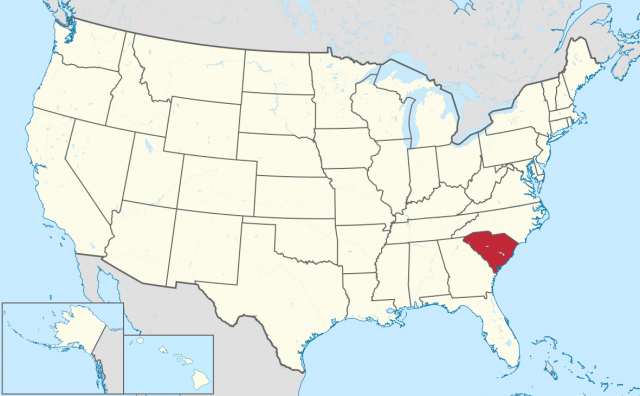The State of South Carolina
AT A GLANCE
Name: South Carolina was named after King Charles I of England.
Nickname: Palmetto State
Capital: Columbia
Size: 31,117 sq. mi. (80,593 sq km)
Population: 4,896,146 (2015 est)
Statehood: South Carolina became the eighth state on May 23, 1788.
Electoral votes: 8 (2016)
U.S. representatives: 6 (until 2016)
State tree: palmetto
State flower: yellow jessamine
State fish: striped bass
Highest point: Sassafras Mountain, 3,560 ft. (1,085 m)

THE PLACE
South Carolina is the smallest of the states in the Deep South. The southeastern twothirds of South Carolina is part of the Atlantic Coastal Plain, which stretches along the Atlantic coast from Maine to Florida. South Carolina residents call the low but sometimes hilly southeast the Low Country. This area has good soil, rivers, swamps, and some pine forests. There are also sand hills left behind from the time when eastern South Carolina was under the Atlantic Ocean.
Western South Carolina is known as the Upcountry, because it is a region of hills that gradually rise into mountains in the northwest corner. Most of South Carolina's major rivers cross through the middle of the state to the Atlantic Ocean and provide good sources of energy.
The Blue Ridge Mountains, part of the Appalachian Mountain system that extends from Maine to Alabama, cross South Carolina in its most northwestern region. The forested Blue Ridge Mountains of South Carolina are lower than the mountains of the same chain in North Carolina.
South Carolina has a warm, subtropical climate. South Carolina receives little snow, and the small amount it does receive usually falls in the mountains. Subtropical plants, such as palmettos and yuccas, grow along the coast. South Carolina has large deposits of clay, limestone, sand, talc, gravel, gold, granite, and topaz.
Facts and Firsts
- ? In 1861, the first battle of the Civil War took place at Fort Sumter.
- ? South Carolina's official state amphibian is the spotted salamander.
- ? At 411 feet (125 m), the Upper Whitewater Falls is the highest waterfall in the eastern United States.
- ? Sumter is home to the largest ginkgo farm in the world.
- ? The Duncan Park baseball stadium in Spartanburg is the oldest minor league stadium in the country.
- ? Myrtle Beach, one of the most popular resort destinations on the East Coast, is in the center of the Grand Strand, a 60-mile (96-km) stretch of South Carolina's best beaches.
- ? At the Riverbanks Zoological Park in Columbia, more than 2,000 animals live in re-created habitats without cages.
THE PAST
The first European settlement in the United States may have been founded in South Carolina. In 1526, Lucas Vasquez de Ayllon, from the colony of Santo Domingo on the island of Hispaniola, started a Spanish settlement named San Miguel de Gualdape on the coast of either present-day South Carolina or Georgia. The settlement lasted less than a year.
England claimed control of all of North America in the early 1600s. Under English control, present-day South Carolina, North Carolina, and Georgia comprised a territory named Carolana that was granted to English noble Sir Robert Heath. Heath did not settle Carolana; King Charles II of England sent the first permanent colonists there in 1669.
During the Revolutionary War, colonists won two battles in South Carolina that helped turn the tide of war against the British. Important American victories took place during the Battle of Kings Mountain in 1780 and at Cowpens in 1781.
After the Revolution, South Carolina strongly supported the right of each state to make its own laws and control its own affairs.
This belief led South Carolina to be the first state to secede from the Union during the Civil War. The first shots of the war were fired at Fort Sumter in 1861.
Before the Civil War, South Carolina's economy depended on large plantations worked by slaves. After the South's defeat and the abolition of slavery, South Carolina's farms were hurt by competition from farms in the West. The state turned to industry, and built textile mills that ran on hydroelectric power from the area's many rivers.
As South Carolina continued to industrialize throughout the 20th century, large river dams were built to supply the necessary energy. In 1953, the Savannah River Plant, one of the first nuclear power plants, was built near Aiken.
THE PRESENT
The growth of its factories and manufacturing industries during the 20th century helped South Carolina to become an important industrial center. Today, South Carolina is one of the leading textile-producing states, with approximately 500 textile factories that produce goods such as acrylic, cotton, polyester, silk, and wool cloth. South Carolina industries also manufacture chemicals such as synthetic fibers, dyes, and pharmaceuticals; industrial machinery; and a variety of wood products from the state's extensive forests. While industrial expansion has brought jobs and economic growth to the state, it has also caused serious air and water pollution problems.
Many traditional agricultural activities, such as growing tobacco, raising broilers (young chickens), and growing crops like cotton, soybeans, and corn, continue today. Approximately one-fourth of South Carolina's land is used for farming, and the state ranks as one of the leading tobacco producers in the United States.
South Carolina maintains strong ties to its history. Antebellum (pre–Civil War) homes and plantations near Charleston attract many tourists who want to experience historic South Carolinian life and farming. Myrtle Beach and Hilton Head are two of the most popular beach resort areas in the United States.
Born in South Carolina
- John C. Calhoun, statesman
- Althea Gibson, athlete
- Dizzy Gillespie, jazz musician and composer
- DuBose Heyward, poet, playwright, and novelist
- Jesse Jackson, civil rights leader
- Eartha Kitt, actress, singer, and dancer
- Francis “Swamp Fox” Marion, soldier
- Ronald McNair, astronaut
- John Rutledge, jurist
- Strom Thurmond, senator
- Charles Townes, physicist
- William Westmoreland, general
- Vanna White, television personality